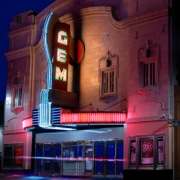Historic restorations provide a lift to 18th & Vine
The historic 18th & Vine Jazz District in greater Downtown Kansas City received some grand attention in the local news media today. Reporter Lynn Horsley wrote today’s lead story about the restoration of five historic homes and one hotel in the 1800 block of Highland.
The story marks a new chapter in the revitalization of this culturally rich neighborhood on the east side of greater Downtown.
Kansas City Star, Jan. 10, 2013 — The tiny wood frame houses on a block just off 18th and Vine were once considered by some people as embarrassing eyesores that needed to be torn down.
But a determined band of historic preservationists saw something very different in those properties, dating from the late 1800s, and launched an epic battle to save them.
They saw the last remnants of what had been a thriving African-American residential neighborhood, filled with doctors and other professionals who fostered the cultural vibrancy for which 18th and Vine is known worldwide.
So the past has been brought back to life, as five formerly forlorn bungalows that now show off new pastel exteriors: robin’s-egg blue, taupe, olive green, mellow yellow and russet-red.
It’s just the most visible sign of the restoration of the historic homes, along with the Rochester Hotel, in the 1800 block of Highland Avenue.
“I’m thrilled with the news that they’re near completion,” said preservation consultant Sally Schwenk, who joined forces in the 1990s with preservation activists Jane Flynn and Mamie Hughes to save the houses. “It’s nice to see, finally after all the work over all the years, that we have arrived at a milestone.”
The houses were built between 1885 and 1913. The Rochester Hotel across the street, where Negro League teams once stayed when in town, was built in 1920.
Hughes remembers when some civic leaders scoffed and said the “shacks” on Highland needed to be demolished.
But she was determined to prevent that from happening.
The district gained national historic designation in 1991, in part because these modest wooden houses reflected the life of middle-class blacks owning property at the turn of the century.
But then the houses were allowed to deteriorate, right across the street from the Mutual Musicians Foundation, one of Kansas City’s two national historic landmarks. The other is the Liberty Memorial.
At one point in 2000, Flynn warned that the area was losing too many original buildings and should be removed from the National Register of Historic Places. City officials rallied to prevent that.
Flynn died in 2006, but both Hughes and Schwenk say they are relieved and gratified at the realization of a long-deferred dream.
“My heart is down there,” Hughes said of the Highland Avenue neighborhood.
Long crusade
The restoration has definitely been a crusade requiring patience and relentless tenacity.
“If ever there was an example of the race is not given to the swift, it was this project,” said Denise Gilmore, president of the Jazz District Redevelopment Corp.
Beginning in 2003, the district spent nearly $400,000 in loans and federal funds to acquire and mothball the houses, the hotel and three vacant lots. Hughes recalls that along with professionals, some dedicated high school students helped clean and stabilize the properties against weather damage and vandalism.
In 2006, the district started working with affordable-housing developer Brian Collins to put together the financing, hoping for low-income and historic tax credits, to turn the hotel and houses into 22 affordable apartments.
They were days away from getting a building permit and starting construction in 2008, when the financial markets collapsed and the project lost the investor who had planned to buy the low-income tax credits.
So back to the drawing board. It took until August 2011 to knit together a new financing package.
The project ultimately will cost about $5 million, including $1.6 million in historic tax credits, $2.3 million from a housing agency receivership case, and about $1 million in federal and city funds.
The cost was way more than the properties are worth from a strictly financial standpoint. But that wasn’t the whole point.
“We’re completing 22 units of housing, at $200,000 per unit and, more importantly, we’re preserving that piece of history for the city,” said Collins, a principal with Dromara Development.
The hotel and five houses are close to completion and should be available for occupancy this month or in early February.
Collins said contractors discovered that the flooring and interior of a sixth house, 1816 Highland, had deteriorated too much to qualify for the historic tax credits. So he is exploring different financing options to finish that house, which he hopes can occur in the next four months.
“We’re going to get that done,” Collins said. “It will happen.”
Labor of love
For the contractor, Greenleaf Construction, work on the five houses and the Rochester Hotel has been a labor of love and meticulous care. Wherever possible, the hardwood floors have been saved and restored. In one house, an authentic slate fireplace has been reconstructed, and in another the entire foundation was rebuilt and set back down. The siding on the houses was taken off to allow for lead paint removal, and then put back on in the same place as if reassembling a puzzle.
“We had trailers full of cleaned trim and siding,” Collins said.
It’s been a good learning experience, said Steven Henderson, project manager with Greenleaf.
“Trying to fit the new into the old, that’s a challenge,” he said.
And there’s much that’s new in these units, including rebuilt interiors with modern appliances such as combo washer/dryers that don’t need to be vented.
Whereas the Rochester Hotel once had about 45 tiny units for transient residents, it now has 12 spacious one- and two-bedroom units on three floors. On the third floor, the west-side unit has impressive views of Downtown, including of the Kauffman Center for the Performing Arts.
The Jazz District already has 246 units of new housing, and completion of this historic preservation project will accomplish the district’s current plans for residential development.
The units are available to people making 80 percent of area median income, which for a two-person family is $45,600. Rents on the units in the houses range from $370 for an upstairs studio apartment at 1826 Highland to $700 for the largest two-bedroom unit on the first floor of 1822 Highland.
Rents in the Rochester are between $490 for smaller one-bedroom units and $675 for the two-bedroom apartments.
Gilmore said most of the 22 units should be available for occupancy early this year, and she’s confident they’ll fill up quickly. She’s been keeping a waiting list of people who have been calling for more than a year.
“If the units are ready,” Gilmore said, “our intent is to get people in.”
Schwenk hopes the houses and neighborhood will be a place for future generations to learn about a bygone era.
“The tangible symbols are what I want my grandchildren to see,” she said. “They’re like totems. They tell us about the past and about the culture.”



